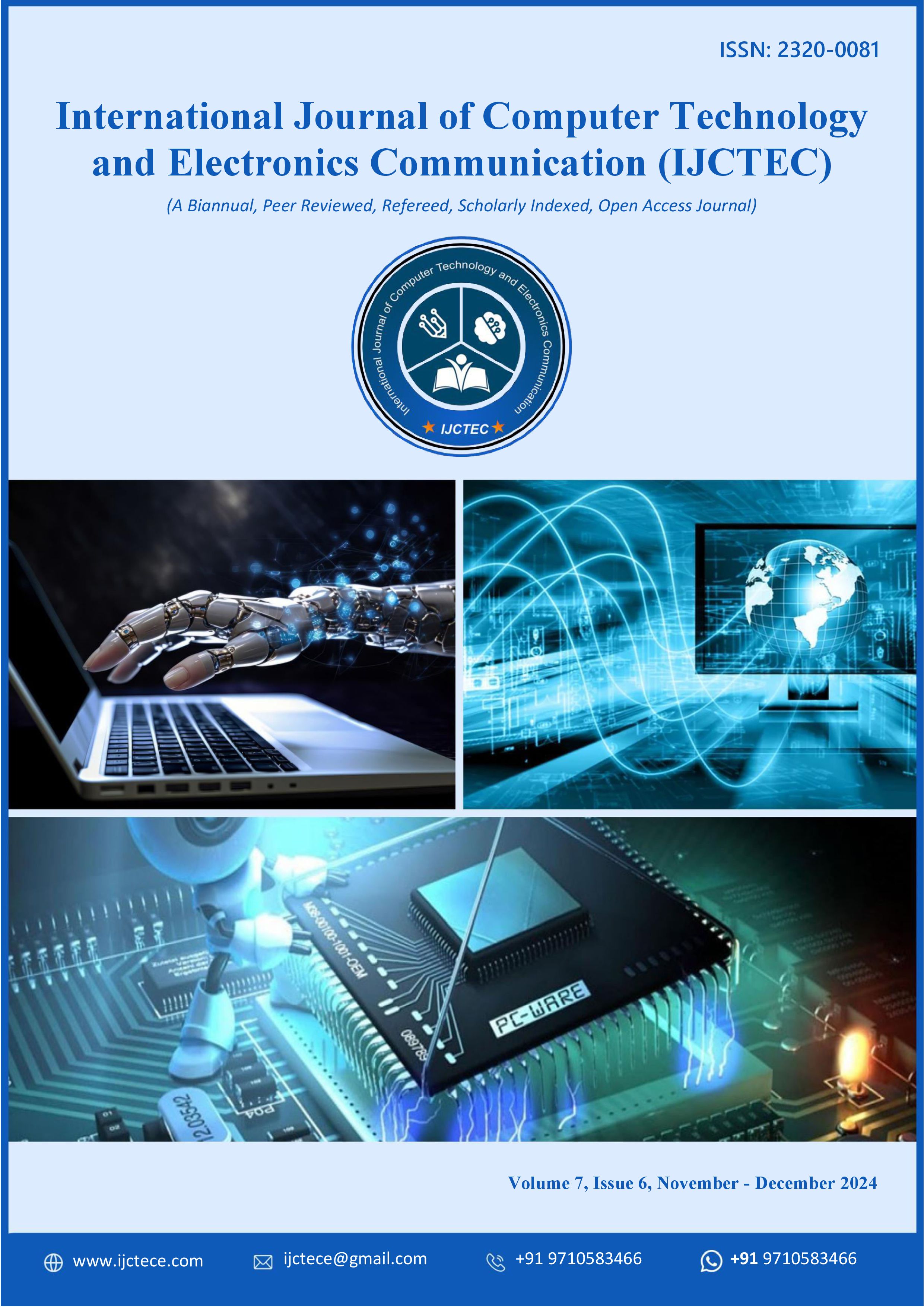Fraud Detection in Banking and Finance: A Multi-Layered Approach using Velocity, Identity, and Location Intelligence
DOI:
https://doi.org/10.15680/IJCTECE.2024.0706004Keywords:
Fraud detection, banking security, velocity checks, device fingerprinting, behavioral analytics, geo-velocity, identity verification, email/phone intelligenceAbstract
Fraud in banking and finance has grown in scale and sophistication with the rise of digital payments and remote onboarding. Traditional rule-based systems alone struggle to counter evolving threats such as synthetic identities, account takeovers, and geo-spoofing. This paper proposes a multi-layered fraud detection framework that integrates velocity and geo-velocity checks, device fingerprinting, behavioral analytics, identity verification, and email/phone intelligence. Through literature review and case studies, the study demonstrates how hybrid approaches combining supervised and unsupervised machine learning with real-time rules can improve detection accuracy, reduce false positives, and preserve customer experience. The findings highlight the importance of layered defenses, privacy-preserving collaboration, and adaptive AI models in addressing modern fraud challenges.
References
[1] M. Flinders, I. Smalley, and J. Schneider, “AI fraud detection in banking,” IBM Think, [Online]. Available: https://www.ibm.com/think/topics/ai-fraud-detection-in-banking?utm_source=chatgpt.com
[2] U.S. Payments Forum, “Card-not-present (CNP) fraud mitigation techniques white paper - Velocity checks,” U.S. Payments Forum, 2022. [Online]. Available: https://www.uspaymentsforum.org/wp-content/uploads/2022/05/Velocity-Checks-2022_legal.pdf?utm_source=chatgpt.com
[3] A. Ali et al., “Financial fraud detection based on machine learning: A systematic literature review,” Appl. Sci., vol. 12, no. 19, Art. no. 9637, Sep. 2022, doi: 10.3390/app12199637.
[4] P. Hajek, M. Z. Abedin, and U. Sivarajah, “Fraud detection in mobile payment systems using an XGBoost-based framework,” Inf. Syst. Front., 2022, doi: 10.1007/s10796-022-10346-6.
[5] U.S. Payments Forum, “Card-not-present (CNP) fraud mitigation techniques white paper - Velocity checks,” U.S. Payments Forum, 2022. [Online]. Available: https://www.uspaymentsforum.org/wp-content/uploads/2022/05/Velocity-Checks-2022_legal.pdf?utm_source=chatgpt.com
[6] “Geo-velocity fraud detection,” Fraud.net, [Online]. Available: https://www.fraud.net/glossary/geo-velocity-fraud-detection?utm_source=chatgpt.com
[7] “Instructions for completing the self-assessment pretest and tally sheet,” Continuum (Minneap Minn), vol. 20, no. 3 Neurology of Systemic Disease, pp. 521–522, Jun. 2014, doi: 10.1212/01.CON.0000450961.38334.c3.
[8] “Device fingerprinting for fraud reduction - How and why does it work?,” SEON, [Online]. Available: https://seon.io/resources/device-fingerprinting/?utm_source=chatgpt.com
[9] “Have I Been Pwned: Check if your email has been compromised in a data breach,” [Online]. Available: https://haveibeenpwned.com/?utm_source=chatgpt.com
[10] “Radar for fraud teams: Rules 101,” Stripe, [Online]. Available: https://stripe.com/guides/radar-rules-101?utm_source=chatgpt.com
[11] R. Drapeau, “How we built it: Stripe Radar,” Stripe Blog, [Online]. Available: https://stripe.com/blog/how-we-built-it-stripe-radar?utm_source=chatgpt.com
[12] “Stripe Radar for fraud teams,” Stripe, [Online]. Available: https://stripe.com/radar/fraud-teams?utm_source=chatgpt.com
[13] [13] R. Drapeau, “How we built it: Stripe Radar,” Stripe Blog, [Online]. Available: https://stripe.com/blog/how-we-built-it-stripe-radar?utm_source=chatgpt.com
[14] “ReMarkable case study,” Stripe, [Online]. Available: https://stripe.com/en-dk/customers/remarkable?utm_source=chatgpt.com
[15] “How to continuously improve your fraud management with Radar for fraud teams and Stripe data,” Stripe, [Online]. Available: https://stripe.com/guides/improve-fraud-management-with-radar-for-fraud-teams-and-stripe-data?utm_source=chatgpt.com
[16] “BioCatch case study: A top-5 U.S. bank detects TrickBot malware attacks with BioCatch’s behavioral biometrics solution,” BioCatch, 2018. [Online]. Available: https://www.biocatch.com/hubfs/Case_Studies/BioCatch_CS_Fraud_Detection%20(4).pdf?hsCtaTracking=16a9fadb-9b70-4300-bf34-c89439a34aa5%7C4578a703-df60-4fdc-8170-8eca3ecec465&utm_source=chatgpt.com
[17] “Credit card fraud detection,” Kaggle Datasets, [Online]. Available: https://www.kaggle.com/datasets/mlg-ulb/creditcardfraud?utm_source=chatgpt.com
[18] “Geo-velocity fraud detection,” Fraud.net, [Online]. Available: https://www.fraud.net/glossary/geo-velocity-fraud-detection?utm_source=chatgpt.com
[19] G. Bontempi, “Combining unsupervised and supervised learning in credit card fraud detection,” ResearchGate, [Online]. Available: https://www.researchgate.net/profile/Gianluca-Bontempi/publication/333143698_Combining_Unsupervised_and_Supervised_Learning_in_Credit_Card_Fraud_Detection/links/5ee889d2458515814a629818/Combining-Unsupervised-and-Supervised-Learning-in-Credit-Card-Fraud-Detection.pdf?utm_source=chatgpt.com
[20] O. L. Finnegan et al., “The utility of behavioral biometrics in user authentication and demographic characteristic detection: A scoping review,” Syst. Rev., vol. 13, no. 61, 2024, doi: 10.1186/s13643-024-02451-1.
[21] M. S. I. Khan, A. Gupta, O. Seneviratne, and S. Patterson, “Fed-RD: Privacy-preserving federated learning for financial crime detection,” arXiv preprint arXiv:2408.01609, 2024.
[22] “A new approach to fighting fraud while enhancing customer experience,” McKinsey & Company, [Online]. Available: https://www.mckinsey.com/capabilities/risk-and-resilience/our-insights/a-new-approach-to-fighting-fraud-while-enhancing-customer-experience?utm_source=chatgpt.com
[23] O. L. Finnegan et al., “The utility of behavioral biometrics in user authentication and demographic characteristic detection: A scoping review,” Syst. Rev., vol. 13, no. 1, p. 61, Feb. 2024, doi: 10.1186/s13643-024-02451-1.
[24] M. S. I. Khan, A. Gupta, O. Seneviratne, and S. Patterson, “Fed-RD: Privacy-preserving federated learning for financial crime detection,” arXiv preprint arXiv:2408.01609, 2024.
[25] D. Lunghi, “Adversarial learning in real-world fraud detection: Challenges and perspectives,” arXiv preprint arXiv:2307.01390, 2023.
[26] “Explainable artificial intelligence (XAI) in finance: A systematic literature review,” Artif. Intell. Rev., 2024, doi: 10.1007/s10462-024-10854-8.
[27] M. S. I. Khan, A. Gupta, O. Seneviratne, and S. Patterson, “Fed-RD: Privacy-preserving federated learning for financial crime detection,” arXiv preprint arXiv:2408.01609, 2024.
[28] D. Lunghi, “Adversarial learning in real-world fraud detection: Challenges and perspectives,” arXiv preprint arXiv:2307.01390, 2023.
[29] “A systematic literature review of blockchain-based applications: Current status, classification and open issues,” Telemat. Informatics, vol. 36, pp. 55–81, Mar. 2019, doi: 10.1016/j.tele.2018.11.006.
[30] “Post-quantum cryptography,” NIST, Jan. 3, 2017. [Online]. Available: https://csrc.nist.gov/projects/post-quantum-cryptography?utm_source=chatgpt.com


